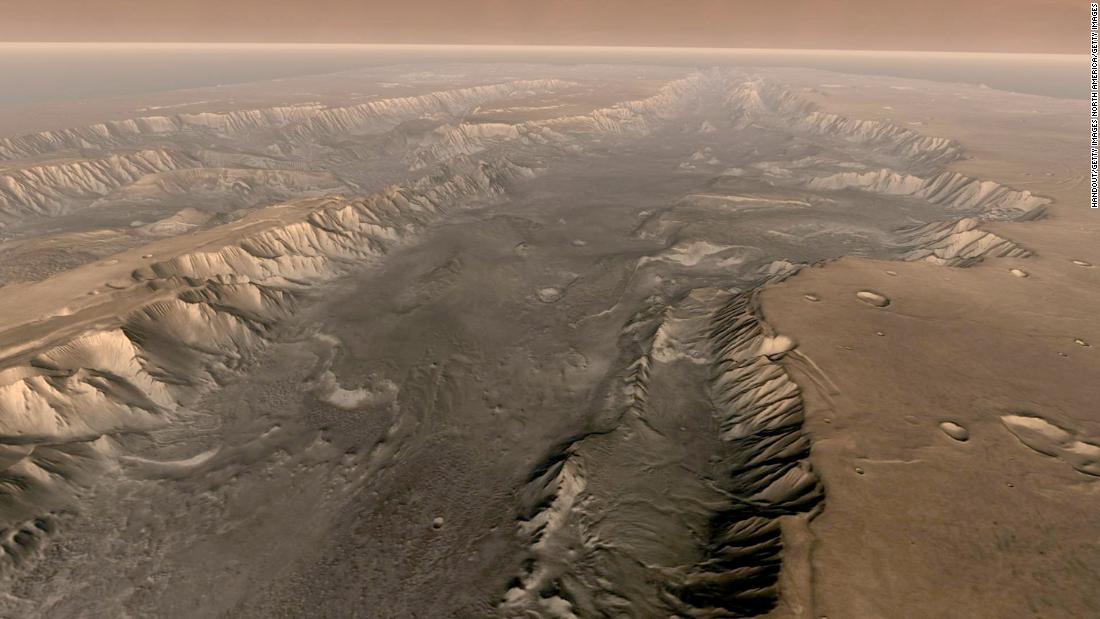(CNN) – Mars has its own version of the Grand Canyon, and scientists have discovered this dramatic feature as “significant amounts of water,” according to the European Space Agency, which discovered the orbit around the red planet.
Exomars Trace Case Orbiter, launched in 2016 as a joint venture between the European Space Agency and Roscosmos, discovered water in the Walls Marineris on Mars. This valley structure is 10 times longer, five times deeper and 20 times wider than the Grand Canyon.
The water is below the surface of the valley system and is detected by the orbiter’s FREND instrument or fine resolution epidermal neutron detector. The instrument is capable of mapping hydrogen in meters above the Martian soil.
Most of the water in the polar regions of Mars freezes into ice. Walls Marineris is located south of the equator Planet, The temperature is usually not cold enough to stay in the water ice.
Observations were collected by Orbiter between May 2018 and February 2021. Previously, other orbiters searched for water beneath the surface of Mars and found small volumes under the dust of Mars. A study describing the findings, published Wednesday in Icarus magazine.
“With (Trace Case Orbiter) we can look up to a meter below this layer of dust and see what’s really going on beneath the surface of Mars, and more importantly, we can not find ‘oases’ full of water.” Igor Mitrofanov said in a statement.
FREND revealed an unusually high level of hydrogen in the vast Valles Marineris Valley system: up to 40% of the surface-to-surface material in this region appears to be water, assuming that the hydrogen we see is bound to water molecules.
To put this forward, this area is approximately the size of the Netherlands. It overflows with Candor Chaos, a network of valleys within the canyon system.
The FREND instrument searches for neutrons to map the hydrogen content in Martian soil. “We can know how much water there is in a soil by looking at the neutrons it emits,” said Alexei Malakov, a senior scientist at the Russian Academy of Sciences’ Space Research Institute.
This is because high-energy particles called “galactic cosmic rays” collide with Mars to form neutrons; dry soil emits more neutrons than wet ones, “he explained in the same report.
“We found that a central part of the Walls Marineris was filled with water, more water than we expected. It’s very similar to the permafrost areas on Earth.
The tool’s unique tracking capabilities allowed the team to locate previously hidden water, Malakov said. It may be ice water or water mixed with minerals in the soil. But scientists believe the ice is high because there is little water in the minerals in this place.
Mars has a high temperature near the equator, so researchers believe there must be a special combination of conditions that allow water to stay and replenish itself.
“This discovery is an exciting first step, but more observations are needed to determine for sure what kind of water we are dealing with,” Hakan Swethem, a former Orbiter project scientist, said in a statement.
“This discovery demonstrates the incomparable capabilities of TGO instruments that allow us to ‘see’ below the surface of Mars, and reveals a large, shallow and easily exploitable reservoir in this part of Mars.”
Future missions to Mars will land at low latitudes. This discovery at Valles Marineris highlights the feature as an enigmatic site for potential human exploration in the years to come, especially as this water will be more accessible than other previously discovered groundwater sources.
“To know more about how and where water is on Mars, it is essential to understand what happened to the water that once abounded on Mars, and to help identify possible living conditions, possible signs of past life, and early organic matter. Tuesdays, ESA’s ExoMars Trace Gas Orbiter project scientist Colin Wilson said in a statement.
In 2022, the Rover Europe Rosalind Franklin And the Russian surface site Kazakh is expected to land on Mars in 2023. The rover will drill beneath the surface of Mars in search of organic matter that would reveal if there was ever life on Mars. The rover will explore the Oxia Planum, which was once the site of ancient exposed clay-filled rocks exposed to water.


:quality(85)/cloudfront-us-east-1.images.arcpublishing.com/infobae/SMPW7M5BQFERBOQUPJXKCOKARY.jpg)
:quality(85)/cloudfront-us-east-1.images.arcpublishing.com/infobae/NP5NEZXMZFGNLBHNEQJHPJVMKM.jpg)

:quality(85)/cloudfront-us-east-1.images.arcpublishing.com/infobae/X7DZAL3I4REJTKPZ4Y4DYBHFMI.jpg)